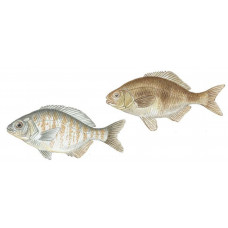Latin name
Rhacocilus toxotes, Amphistichus argenteus
Other names
Seaperch, surffish.
Identification
They have a compressed body, more or less oval, usually silvery, and large fleshy lips. The spiny and soft-tipped dorsal fins are fused. They mainly consume small crustaceans, but some also eat worms, small crabs, shrimp, and mussels. Shiner surfperch are typically greenish or silvery. The sides of the Barred surfperch are marked by a series of dusky, copper vertical stripes with spots between them. The back and sides are gray to olive. Rubberlip surfperch is characterized by thick white to pinkish colored lips. The whitish background color is normally tinged with a smoky or blackish hue, and the pectoral fins are yellow.
Distribution
Surfperch is distributed in the eastern Pacific Ocean. Two members of this family are found off the coast of Japan and Korea, and the rest are found along the Pacific coast of North America from Alaska to Baja California, Mexico. They are all marine, except for the small tule perch (Hysterocarpus traski), which is found in California's Sacramento and Russian rivers. Shiner surfperch (Cymatogaster aggregata) is found from Baja California, Mexico, to Wrangell, Alaska. Barred surfperch occurs from central California to Baja California. Rubberlip surfperch inhabits from central to southern California.
Habitat
Most species live in the surf along sandy and rocky shores, but a few species live in bays or similarly shallow coastal waters. One species lives in relatively deep water (to more than 700 feet) and two smaller species live only in tidal pools. Shiner surfperch is most common in bays and thickets of elgrass, as well as near piers and jetties. Barred surfperch is found along sandy shores.
Size
The maximum size ranges from 4 to 18 inches. Shiner surfperch grow to a maximum size of 8 inches. The barred surfperch (Amphistichus argenteus) reaches a maximum size of 17 inches and 41⁄2 pounds, although it is usually much smaller. The largest member of the surfperch family, the rubberlip surfperch (Rhacocilus toxotes), reaches 18 inches.
Life history and Behavior
No information
Food and feeding habits
No information
Reproduction
Surfperch is a rare species among marine fish because it is viviparous, or produces live offspring. Unlike most other fish, female Surfperch do not scatter eggs outside their bodies, but feed the young inside them and then hatch them alive into the surf.
| Classification | |
| Phylum | Chordata |
| Class | Actinopterygii |
| Family | Embiotocidae |
| Features | |
| Conservation status | No information |
| Habitat | Pelagic |
| Life span, years | No information |
| Maximum body weight, kg | No information |
| Maximum length, cm | 47 |
| Sailing speed, m/s | No information |
| Threat to people | Edible |
| Way of eating | Predator |



